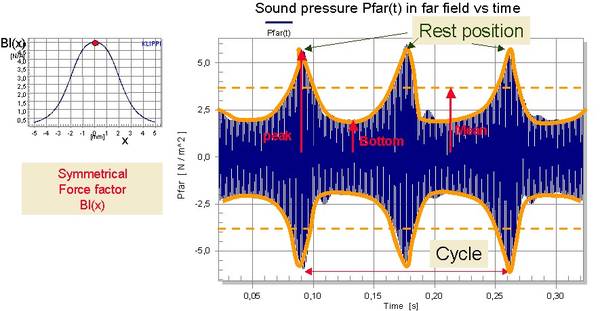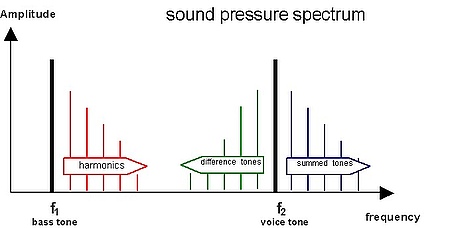Intermodulation Distortion
Characteristics: | KLIPPEL R&D System |
|---|---|
Nth-order difference-tone and summed-tone intermodulation | DIS, SIM |
Total intermodulation distortion (absolute and relative) | DIS, SIM |
Amplitude modulation distortion | DIS, SIM |
A nonlinear system generates new spectral components which are not in the stimulus. In addition to harmonics, the fundamental components interact with each other and generate difference-tone and summed-tone components in the output signal (see figure below). In the time domain the intermodulation causes a variation of the phase (instantaneous frequency) or an amplitude modulation of the envelope. Loudspeakers and other electro-acoustical transducers generate significant intermodulation distortions in the audio band which have a significant impact on the perceived sound quality. The inductance nonlinearity L(x) produces low harmonic distortions at low frequencies but generates wide-band intermodulation which rise to significant values (30 %) at higher frequencies. Intermodulation distortion can easily be detected by using a two-tone signal with varying frequencies of the excitation tones (“bass tone sweep” or “voice tone sweep”).


The figure to the left illustrates the interpretation of the intermodulation distortion measurement using a fixed low frequency tone f1 and a high frequency tone f2 which is varied over the audio band (“voice tone sweep”). While the stiffness nonlinearity can not produce significant intermodulation, the other nonlinearities generate wide-band distortion which can not be detected by a harmonic distortion measurement.
The figure to the left shows the intermodulation of a high frequency tone f2 by a low frequency tone f1 caused by a nonlinear force factor Bl(x) characteristic. If the voice coil is at the rest position x=0 the instantaneous value of Bl(x=0) is maximal and generates the peak in the envelope of the sound pressure signal. For a negative and positive peak excursion, the Bl-value becomes minimal generating the bottom values of the envelope. The temporal variation of the envelope of the high-frequency generates a fluctuation and roughness in the perceived sound.
KLIPPEL R&D SYSTEM (development)
Module | Comment |
|---|---|
| Simulation (SIM) | SIM module predicts the intermodulation distortion using a large signal model and the measured linear and nonlinear lumped parameters of the loudspeaker. The results are presented in a similar format like the DIS module. |
DIS module provides a two-tone stimulus to perform intermodulation measurements according to common international standards. DIS also separates amplitude modulation distortion and reveals the variation of the envelope. |
Templates of KLIPPEL products
Name of the Template | Application |
|---|---|
DIS IM Dist. (bass sweep) | Intermodulation distortion in current and sound pressure using a variable bass tone fs/4 < f1 < 4fs and a fixed voice tone f2 >> fs |
DIS IM Dist. (voice sweep) | Intermodulation distortion in current and sound pressure by using a fixed bass tone f2 < fs and a variable voice tone f1>> fs |
DIS Separation AM Distortion | Amplitude modulation distortion according Application Note AN 10 |
Diagnost. MIDRANGE Sp1 | Comprehensive testing of midrange drivers with a resonance 30 Hz < fs < 200 Hz using standard current sensor 1 |
Diagnost. RUB&BUZZ Sp1 | Batch of Rub & Buzz tests with increased voltage (applied to high power devices) |
Diagnost. RUB & BUZZ Sp2 | Batch of Rub & Buzz tests with increased voltage (applied to low power devices) |
Diagnost. SUBWOOFER (Sp1) | Comprehensive testing of subwoofers with a resonance 10 Hz < fs < 70 Hz using standard current sensor 1 |
Diagnostics MICROSPEAKER Sp2 | Comprehensive testing of microspeakers with a resonance 100 Hz < fs < 2 kHz using sensitive current sensor 2 |
Diagnostics TWEETER (Sp2) | Comprehensive testing of tweeters with a resonance 100 Hz < fs < 2 kHz using sensitive current sensor 2 |
Diagnostics VENTED BOX SP1 | Comprehensive testing of vented box systems using standard current sensor 1 |
Diagnostics WOOFER (Sp1) | Comprehensive testing of subwoofers with a resonance 30 Hz < fs < 200 Hz using standard current sensor 1 |
Diagnostics WOOFER Sp1,2 | Comprehensive testing of subwoofers with a resonance 30 Hz < fs < 200 Hz using current sensor 1 and 2 |
SIM IM Dist. (bass sweep) | Intermodulation distortion in current and sound pressure by using a variable bass tone fs/4 < f1 < 4fs and a fixed voice tone f2 >> fs, simulated results are comparable with DIS IM Dist. (bass sweep) |
SIM IM Dist. (voice sweep) | Intermodulation distortion in current and sound pressure by using a fixed bass tone f2 < fs and a variable voice tone f1>> fs; Simulated results are comparable with DIS IM Dist. (voice sweep). |
SIM Separation AM Distortion | Amplitude modulation distortion according Application Note AN 10; Simulated results are comparable with DIS Separation AM Distortion. |
SIM closed box analysis | Maximal displacement, dc displacement, compression, SPL, distortion using large signal parameters imported from LSI BOX |
SIM vented box analysis | Maximal displacement, dc displacement, compression, SPL, harmonic distortion using large signal parameters imported from LSI BOX |
Application Notes
AN 4 Measurement of Peak Displacement Xmax (performance-based method)
AN 8 3D Intermodulation Distortion Measurement
AN 10 AM and FM Distortion in Speakers
AN 16 Multi-tone Distortion Measurement
AN 24 Measuring Telecommunication Drivers
AN 37 Characteristic Modulation Distortion
AN 41 Measurement at defined terminal voltage
Standards
Audio Engineering Society
AES2 Recommended practice Specification of Loudspeaker Components Used in Professional Audio and Sound Reinforcement
International Electrotechnical Commission
IEC 60268-5 Sound System Equipment, Part 5: Loudspeakers
Other Related Tests
Typical Test Objects
Papers and Preprints
W. Klippel, Tutorial “Loudspeaker Nonlinearities - Causes, Parameters, Symptoms,” J. of Audio Eng. Soc. 54, No. 10, pp. 907-939 (2006 Oct.).
W. Klippel, “Equivalent Input Distortion,” J. of Audio Eng. Soc. 52, No. 9, pp. 931-947 (2004 Sept.).
W. Klippel, “Assessment of Voice-Coil Peak Displacement Xmax,” J. of Audio Eng. Soc. 51, Heft 5, pp. 307 - 323 (2003 May).
W. Klippel, U. Seidel, “Measurement of Impulsive Distortion, Rub and Buzz and other Disturbances,” presented at the 114th Convention of the Audio Eng. Soc., 2003 March 22–25, Amsterdam, The Netherlands, Preprint 5734.
E. Czerwinski, “Air-Related Harmonic and Intermodulation Distortion in Large Sound Systems,” J. of Audio Eng. Soc., Volume 47, No. 6, pp. 427-446, June 1999.
A. Voishvillo, “Graphing, Interpretation, and Comparison of Results of Loudspeaker Nonlinear Distortion Measurements,” J. of Audio Eng. Soc., Volume 52, No. 4, pp. 332-357, April 2004.
D. Clark, “Amplitude Modulation Method for Measuring Linear Excursion of Loudspeakers,” presented at the 89th Convention of the Audio Eng. Soc., J. of Audio Eng. Soc. (Abstracts), Volume 38, p. 874 (1990 Nov.), Preprint 2986.
R. H. Small, “Measurement of Loudspeaker Amplitude Modulation Distortion,” presented at the 114th Convention of the Audio Eng. Soc. in Amsterdam, March 22 – 25, 2003, Preprint 5731.

